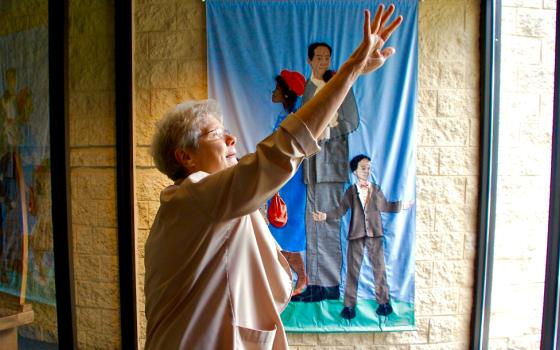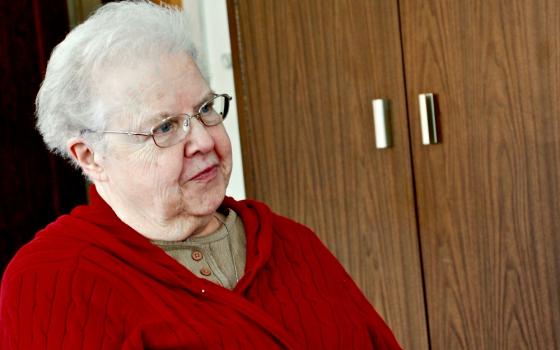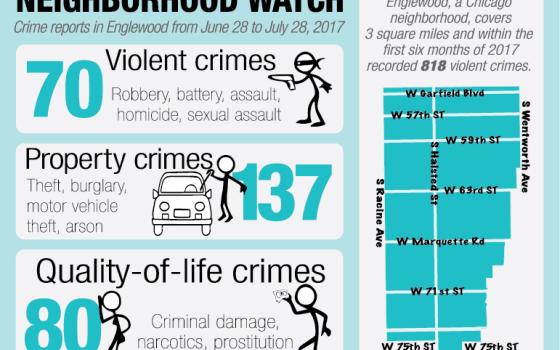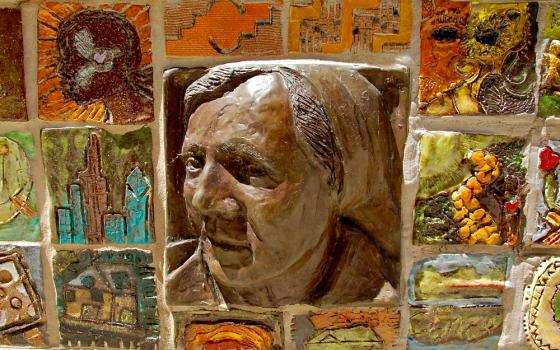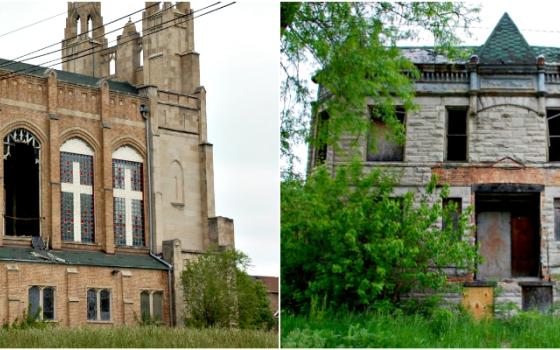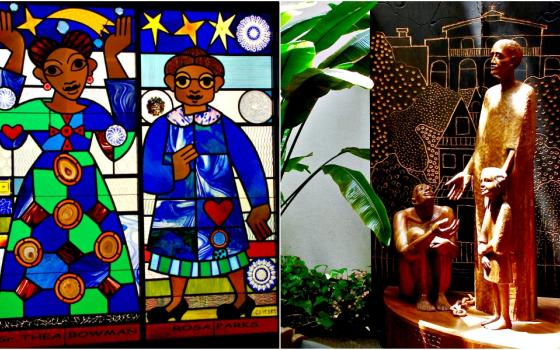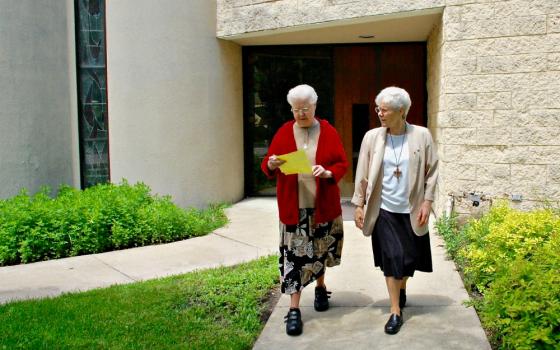Springfield Dominican Srs. Joanne Delehanty and Mary Pokorny sit in a church office, talking about the neighborhood they have lived in for nearly 30 years. Their smiles, the room in the old brick structure and the lush trees outside suggest an oasis of peace in a busy city.
But Englewood, 8 miles south of downtown Chicago, has seen anything but peace for more than 50 years.
"There's an entropy that happens, a disorganization that just became the norm in this neighborhood, and that's a really hard thing to work with," Delehanty said.
Englewood, which covers just 3 square miles, was home to 818 violent crimes (including homicides, robberies and assaults) in the first six months of this year, according police statistics compiled by the Chicago Tribune. When Cardinal Blase Cupich led a combined peace march and Stations of the Cross on Good Friday this year, he led it through Englewood.
By then, Chicago as a whole was already getting national attention for its number of shootings. At least 755 people had been shot by the time of Cupich's march in April, the Chicago Tribune reported. In 2016, more than 4,300 people were shot in Chicago and more than 760 were killed, the newspaper said, making it the most violent year in two decades.
Delehanty and Pokorny are two of the many women religious in Chicago working to bring peace to streets torn by violence. Some do it by running schools, health clinics or social programs. Others do it in smaller ways, concentrating not on changing neighborhoods or even city blocks, but individual lives.
"We're under no illusions. We would never, ever presume to say we've changed anything," Delehanty said. "Our energy goes into being church and being good neighbors."
Where once neighborhood disputes were solved with fists or, at worst, knives, the drug trade and easy availability of guns have made the violence far deadlier, while younger and younger gang members have made it more haphazard in the last 25 years, Delehanty said.
Englewood's business district at 63rd Street and South Halstead Street once rivaled downtown Chicago, Pokorny said. Then came the "white flight" of the 1950s, during which not only white residents moved away to the suburbs, but businesses followed. That left empty buildings and few jobs for the African-Americans who thought they were getting a chance to move into a better area. Unemployment and falling property values led to poverty and crime and started a spiral where each factor seemed to worsen the others.
Arthur Eiland, 93, moved into Englewood in 1952 and still has a copy of the letter he received from a confused real estate agent saying he should sell his house: Property values in Englewood were declining because of blacks moving in.
"I guess he couldn't figure out my race by my last name," he said.
Values fell again in later decades, when "we also had the flight of our middle-class blacks," Eiland said, leaving a neighborhood with even more concentrated poverty and more problems.
The population of the neighborhood was once 80,000, Eiland said. In 2010, it was 30,000, according to statistics compiled by the Chicago Tribune. Currently, 42 percent of households have incomes below the federal poverty level, which is $24,600 for a family of four, and the unemployment rate is 21 percent, compared to June's national unemployment rate of 4.4 percent. Nearly one-third of adults in Englewood do not have a high school diploma.
Add in drugs, gangs and the easy availability of guns, and the result is deadly: The neighborhood recorded six homicides in June alone, plus 102 assaults and batteries, 44 robberies, 42 vehicle thefts, 32 prostitution arrests and 43 drug abuse cases, according to police statistics.
"Twenty-five years ago, it would be an accident if you were shot," Delehanty said. "Now there's just all this indiscriminate shooting."
The Chicago Benedictines' St. Scholastica Monastery is in the Rogers Park neighborhood on Chicago's north side and has been largely separated from the violence plaguing the west and south sides of the city. But it hasn't been immune.
In 2014, a man was gunned down across the street from the monastery. In March 2016, an 18-year-old man was shot to death, practically on the monastery's front steps.
Each time, the sisters organized a peace vigil based on the Take Back the Site program started by women religious in Erie, Pennsylvania.
"Our main purpose was to say no to all violence. Because once a terrible act hits a city, everybody's heart is touched by it," said Benedictine Sr. Benita Coffey, the congregation's social justice promoter. "It's every person's responsibility to open our hearts and remember that every person that meets us has to find respect and tolerance."
Coffey said she knows a vigil will not end violence. But she also knows the vigil can lead to what will: relationships.
"We want to make the neighborhood safe, but it's going to be safe by talking to each other," she said. "How many times do we pass by people like they're wooden?"
Coffey said the sisters and the neighbors have a great relationship with the Chicago Police Department and city officials, but they're not waiting for leaders to come solve the violence. Instead, they're trying to foster an atmosphere of trust and acceptance, working to build relationships with and among neighbors so disputes don't become violent.
That's an idea taken to heart in the southwest Chicago neighborhood of Chicago Lawn, where the Southwest Organizing Project has worked to restore relationships in the area. St. Casimir Sr. Margaret Zalot has been active in the group since its founding in 1996 to fight predatory lending.
"It's all connected to safety and the viability of the neighborhood," Zalot said. "These are the issues that make you comfortable wherever you're staying. ... The housing piece wouldn't work without the safety piece and the education piece. All these things affect everything."
Chicago Lawn was once a Lithuanian enclave, predominantly white and predominantly Catholic, and became famous in 1966 when the Rev. Martin Luther King Jr. marched there to demonstrate for open housing, only to be met by an angry mob throwing bricks and rocks, one of which struck him in the head.
In the decades that followed, the neighborhood did become more diverse, with whites leaving for the suburbs and African-Americans and Hispanics moving in, Zalot said.
"These large and rapid demographic shifts resulted in the breakdown of institutional and neighborhood cohesion, as long-term residents moved out and new residents moved in," the Southwest Organizing Project website states. "Families no longer knew one another — the old networks were gone and new ones needed to be created."
Whites who had left the area still came back for Mass in their old parishes but knew none of the neighbors and left as quickly as they could, Zalot said.
"As the neighborhood changed, the sisters stayed," said Paula Staisiunas Schultz, who grew up in the Chicago Lawn neighborhood and is now communications coordinator for the Sisters of St. Casimir. "They were encouraged to move to the western suburbs, but they said, 'No, we're here to serve the people of the community, whoever that may be.' "
For decades, the Sisters of St. Casimir ran Holy Cross Hospital and a school and had a large motherhouse. Now, with most of the sisters moved to a nursing home, only seven remain in the complex.
As the economics of the area changed, Holy Cross Hospital's economics changed, too, and the sisters tried for years to find a buyer to avoid closure. Finally, Sinai Health System purchased it in 2012; Holy Cross is now a Catholic hospital within a Jewish health system, and a sister sits on the Sinai board.
The sisters' school is now a public charter school, and Catholic Charities uses most of the motherhouse. The sisters also started a nonprofit, the Maria Kaupas Center, to run afterschool programs.
All of those institutions, Zalot said, could have been shuttered and left empty.
"The hospital could have closed, the school could have closed, and we would have been out of here," Zalot said. "But we were able to transform things and form partnerships, so the mission of Holy Cross Hospital continues. The mission of education continues. And with Catholic Charities in the motherhouse, the mission of social service continues."
Those missions, combined with efforts to improve housing, fighting for the rights of people living in the country illegally, and the efforts of the Southwest Organizing Project to empower residents to improve their neighborhood, are the things that tear at the roots of violence, Zalot said.
Jeff Bartow, executive director of the Southwest Organizing Project, said the holistic approach the Sisters of St. Casimir have brought to the group and the neighborhood has been critical.
"They're on the ground, listening and engaging with people on the issues important to families," Bartow said. "We have meetings where we always take a little time to do one-on-one conversations with people we don't know, and it's not uncommon to see the sisters sitting down with young African-American men and engaging them. The combination of boldness and care on both sides is powerful."
The efforts to build community in Chicago Lawn are working, Zalot said.
"There were so many boarded-up houses last year that are not boarded up anymore," Zalot said. "They're not only fixed up, but people are wanting to move in because they have a connection to the institutions in the neighborhood."
People have wanted to move into the Englewood neighborhood, too, Pokorny said, but mainly because the price of houses and land was so low, incoming residents could afford to either restore an old house or build a new one.
Those new and rehabbed houses form a strange outpost amid empty lots, an abandoned church with its stained-glass windows smashed out, and boarded-up buildings. Yet there are signs of development, with a miniature Whole Foods and other stores moving in.
Many of the newer houses were constructed near St. Bernard Hospital, which was built in the 1800s by the Religious Hospitallers of St. Joseph, a Canadian congregation that ran the hospital for decades and believed good housing was a key to building good health.
Still, those are islands in a sea of despair. Another island of hope in Englewood is St. Benedict the African Catholic Church, an amalgamation of five churches in the area built in 1989 both to honor the parishioners' African-American heritage and to be welcoming to everyone.
"You had these church buildings built to house thousands of parishioners that were down to hundreds or dozens of members," Delehanty said. "One church had a $10,000 a month heating bill and only 125 parishioners."
She said that despite the shameful treatment African-American Catholics received in white parishes in the 1960s — seated by ushers in the back row, passed over at Communion — they insisted that their new church building be designed to make everyone feel at home. The parish has about 300 individual members.
The parish and neighborhood are home for Pokorny and Delehanty. Pokorny at first only worked in Englewood and lived elsewhere until a woman pointed out that it's hard to take advice from someone who does not live there.
"Sister, you can drive out of here at night," she said the woman told her.
She and Delehanty have lived there ever since, and neither has plans to leave.
"It would be hard to go back to a white church after 30 years," Pokorny said, laughing.
Eiland said neighbors dread the day the two, the only sisters currently working in Englewood, aren't there anymore. Delehanty is 67 and Pokorny is 80.
"They're irreplaceable," he said. "I think their presence makes a big difference."
[Dan Stockman is national correspondent for Global Sisters Report. His email address is [email protected]. Follow him on Twitter or on Facebook.]
